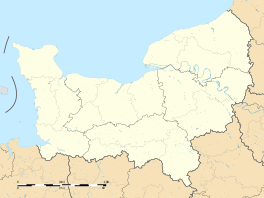Flers, Orne
| Flers | ||
|---|---|---|

Château de Flers
|
||
|
||
| Coordinates: 48°45′06″N 0°33′38″W / 48.7518°N 0.5605°WCoordinates: 48°45′06″N 0°33′38″W / 48.7518°N 0.5605°W | ||
| Country | France | |
| Region | Normandy | |
| Department | Orne | |
| Arrondissement | Argentan | |
| Canton | Flers-Nord and Flers-Sud | |
| Intercommunality | Pays de Flers | |
| Government | ||
| • Mayor (2001–2008) | Yves Goasdoué | |
| Area1 | 21.15 km2 (8.17 sq mi) | |
| Population (2012)2 | 14,968 | |
| • Density | 710/km2 (1,800/sq mi) | |
| Time zone | CET (UTC+1) | |
| • Summer (DST) | CEST (UTC+2) | |
| INSEE/Postal code | 61169 /61100 | |
| Elevation | 182–276 m (597–906 ft) (avg. 189 m or 620 ft) |
|
| Website | http://www.agglo-paysdeflers.fr/ | |
|
1 French Land Register data, which excludes lakes, ponds, glaciers > 1 km² (0.386 sq mi or 247 acres) and river estuaries. 2Population without double counting: residents of multiple communes (e.g., students and military personnel) only counted once. |
||
| Year | Owner |
| 1901 | The town buys the castle |
| 1820–1901 | Schnetz family |
| 1806–1820 | de Redern family |
| 1736–1806 | de La Motte-Ango family |
| 1547–1736 | de Pellevé family |
| 1404–1547 | de Grosparmy family |
| 1396–1404 | Guillaume de Tournebu |
| 1320–1396 | Robert III d'Harcourt Robert IV d'Harcourt Robert V d'Harcourt |
| 1180–1320 | Foulques d'Aunou Thomas d'Aunou |
| 10th to 12th century | de Flers family |
1 French Land Register data, which excludes lakes, ponds, glaciers > 1 km² (0.386 sq mi or 247 acres) and river estuaries.
Flers is a commune in the Orne department in north-western France.
The inhabitants are called Flériens.
Flers is bordered to the north by the communes of Saint-Georges-des-Groseillers and Aubusson, to the north-east by Ronfeugerai, to the west by La Lande-Patry and Saint-Paul, to the south-west by La Chapelle-Biche, La Chapelle-au-Moine and Messei, and to the south-east by La Selle-la-Forge.
The commune is situated in the north-west of the Orne département, about ten kilometres from the border of the Calvados, an hour east of Granville, and two hours by train from Paris. It depends on a prefecture located an hour north in Caen.
The commune is crossed by the river Vère which ends in the river Noireau in Pont-Erembourg (commune of Saint-Denis-de-Méré).
Flers is part of the region that stretches from the Bocage to the Écouves forest, the wettest part of the Orne département, with relatively mild temperatures thanks to its proximity to the English Channel and the effect of the sea. It benefits from an oceanic climate with mild winters and temperate summers.
The first written mentions of Flers appear at the end of the twelfth century as Flers (1164–1179) or Flex (1188–1221). Some authors think that the name of the town derives from the German toponym Hlaeri, meaning wasteland or common grazing land, while others suggest an origin in the German Fliessen, from the Dutch vliet or the Latin fluere latin Fluere, indicating a waterflow, basin or marsh. Yet another etymology links Flers to the Latin flexus, meaning the bend in a road or river. Finally, the Breton term fler or flear means bad smell, indicating the stench of stagnant water. All etymologies seem to agree however that the town is named for its topography and the water close to it.
...
Wikipedia



